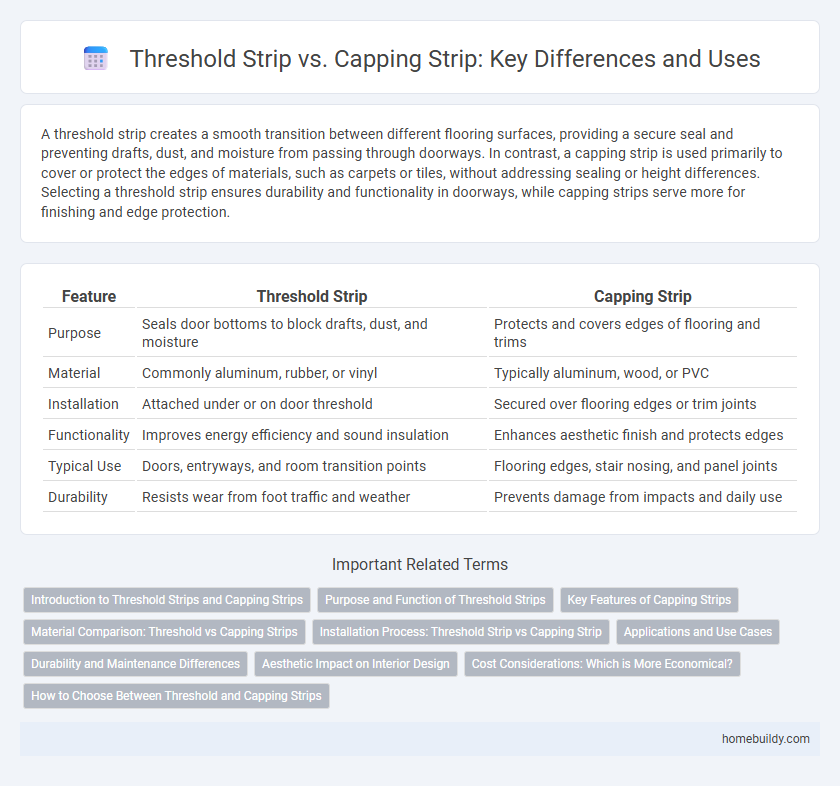A threshold strip creates a smooth transition between different flooring surfaces, providing a secure seal and preventing drafts, dust, and moisture from passing through doorways. In contrast, a capping strip is used primarily to cover or protect the edges of materials, such as carpets or tiles, without addressing sealing or height differences. Selecting a threshold strip ensures durability and functionality in doorways, while capping strips serve more for finishing and edge protection.
Table of Comparison
| Feature | Threshold Strip | Capping Strip |
|---|---|---|
| Purpose | Seals door bottoms to block drafts, dust, and moisture | Protects and covers edges of flooring and trims |
| Material | Commonly aluminum, rubber, or vinyl | Typically aluminum, wood, or PVC |
| Installation | Attached under or on door threshold | Secured over flooring edges or trim joints |
| Functionality | Improves energy efficiency and sound insulation | Enhances aesthetic finish and protects edges |
| Typical Use | Doors, entryways, and room transition points | Flooring edges, stair nosing, and panel joints |
| Durability | Resists wear from foot traffic and weather | Prevents damage from impacts and daily use |
Introduction to Threshold Strips and Capping Strips
Threshold strips are essential components installed at doorways to provide a smooth transition between different flooring surfaces while enhancing durability and accessibility. Capping strips serve a complementary role by covering and protecting edges of carpets or flooring materials, preventing fraying and wear. Both threshold strips and capping strips contribute to improved safety, aesthetic appeal, and longevity of floor installations in residential and commercial settings.
Purpose and Function of Threshold Strips
Threshold strips serve as protective and decorative elements installed at doorways to bridge gaps between different flooring materials, providing a smooth transition and preventing tripping hazards. They enhance durability by sealing door thresholds against moisture, drafts, and dirt infiltration, contributing to energy efficiency and interior comfort. Unlike capping strips, which primarily cover and secure the edges of floorings without bridging transitions, threshold strips focus on functional connectivity and safety between varying floor levels.
Key Features of Capping Strips
Capping strips provide a durable, protective covering designed to seal and finish the edges of surfaces, preventing moisture ingress and wear over time. Key features of capping strips include their resistance to weathering, ease of installation with adhesive or nails, and compatibility with various materials such as wood, metal, and concrete. Unlike threshold strips, which primarily serve as transition pieces between flooring surfaces, capping strips focus on edge protection and aesthetic enhancement.
Material Comparison: Threshold vs Capping Strips
Threshold strips are typically made from durable materials such as aluminum, wood, or rubber, offering excellent resistance to wear and weather conditions. Capping strips, usually constructed from softer plastics or vinyl, provide a lightweight and flexible solution mainly for covering and protecting edges. The choice between threshold and capping strips depends on the intended use, with thresholds prioritizing strength and durability, and capping strips focusing on aesthetic edge finishing and protection.
Installation Process: Threshold Strip vs Capping Strip
The installation process of a threshold strip involves securing it to the floor at doorways to create a smooth transition between different flooring materials, often requiring precise measurements and drilling for screws or adhesive application. In contrast, a capping strip installation focuses on covering and sealing exposed edges or joints, typically requiring less floor preparation but careful alignment to ensure a clean, finished appearance. Both require specific tools and materials, but threshold strips demand more structural alignment for durability and safety in high-traffic areas.
Applications and Use Cases
Threshold strips are primarily used to bridge gaps between different flooring types, ensuring smooth and safe transitions in doorways and entry points. Capping strips serve to cover and protect the exposed edges of flooring materials, preventing damage and providing a finished look, especially along stairs and wall perimeters. Both strips find applications in residential, commercial, and industrial spaces, with threshold strips emphasizing transition and safety, while capping strips prioritize edge protection and aesthetic enhancement.
Durability and Maintenance Differences
Threshold strips offer superior durability compared to capping strips due to their robust materials designed to withstand heavy foot traffic and environmental wear. Maintenance requirements for threshold strips are minimal as they resist corrosion and physical damage, whereas capping strips often need regular inspection and replacement due to lower resistance to moisture and impact. Choosing threshold strips ensures long-lasting performance with less frequent upkeep, enhancing overall building efficiency.
Aesthetic Impact on Interior Design
Threshold strips offer a seamless transition between flooring materials, enhancing the overall aesthetic by maintaining a smooth and continuous look in interior design. Unlike capping strips, which can create a noticeable ridge or edge, threshold strips provide a subtle, low-profile finish that blends effortlessly with diverse decor styles. This sleek appearance supports minimalistic and modern design themes, preserving visual flow and preventing disruption in room cohesion.
Cost Considerations: Which is More Economical?
Threshold strips generally offer a more economical solution compared to capping strips due to their simpler installation process and lower material costs. Capping strips often require specialized tools and more labor-intensive application, increasing overall expenses. Budget-conscious projects typically favor threshold strips for cost efficiency without sacrificing durability.
How to Choose Between Threshold and Capping Strips
When choosing between threshold strips and capping strips, consider the specific application: threshold strips are ideal for covering gaps between different floor types and providing a smooth transition, while capping strips protect the edges of flooring from damage and create a finished look. Evaluate the flooring material, height difference, and traffic frequency to determine the appropriate strip type that ensures durability and safety. Selecting the right strip enhances floor longevity and maintains aesthetic appeal in doorways and room transitions.
threshold strip vs capping strip Infographic

 homebuildy.com
homebuildy.com